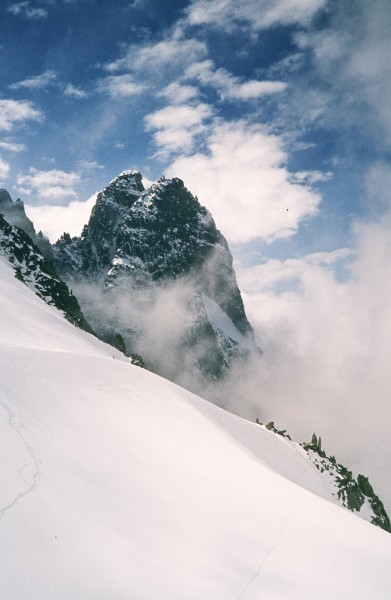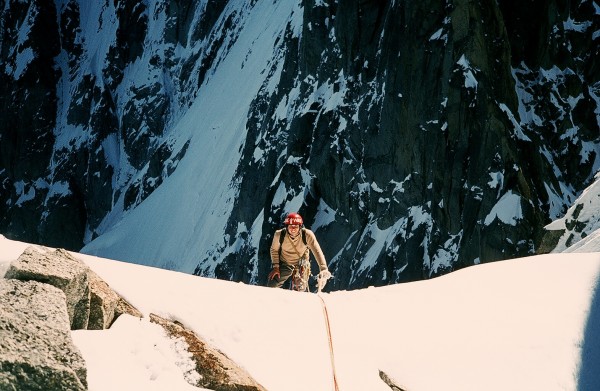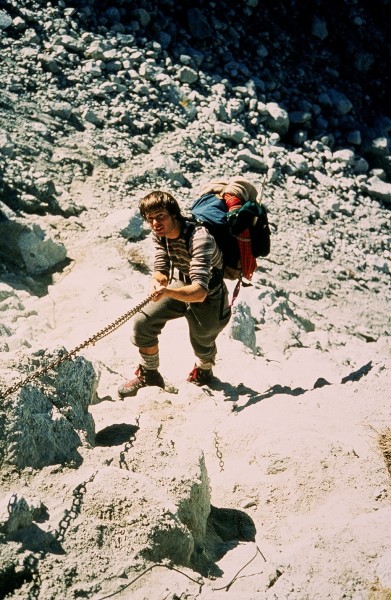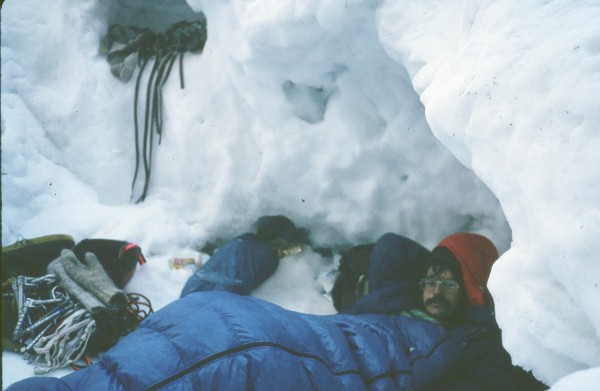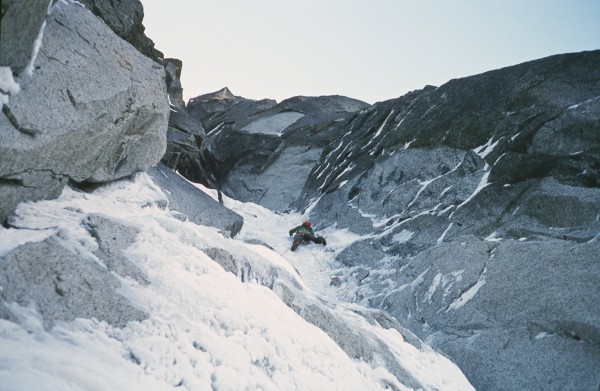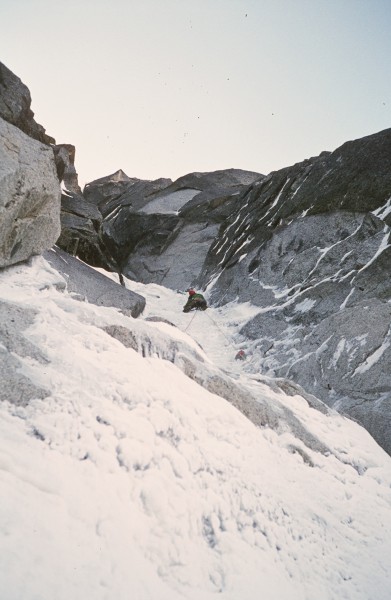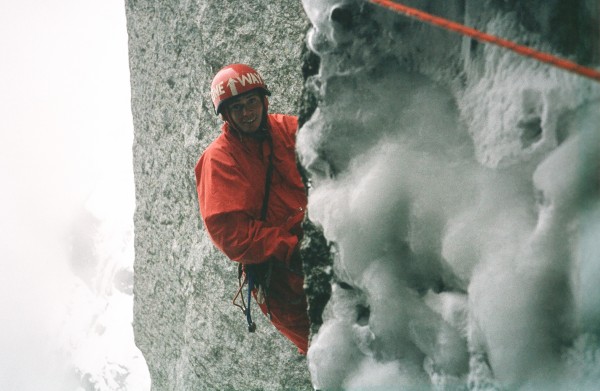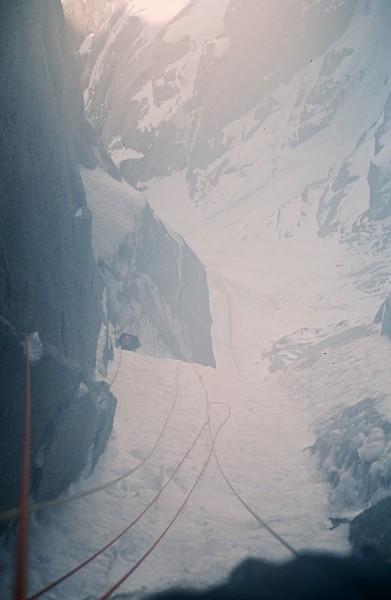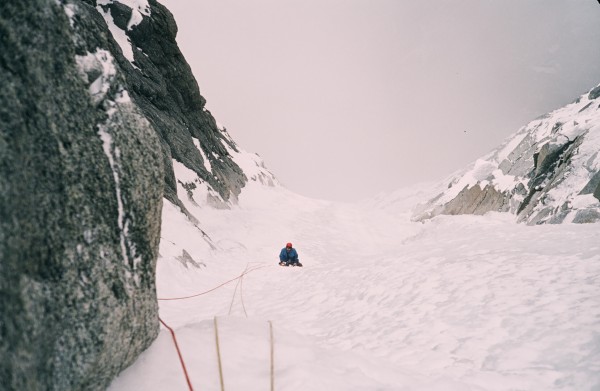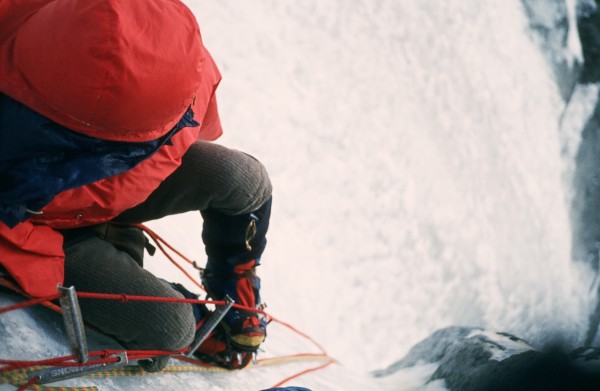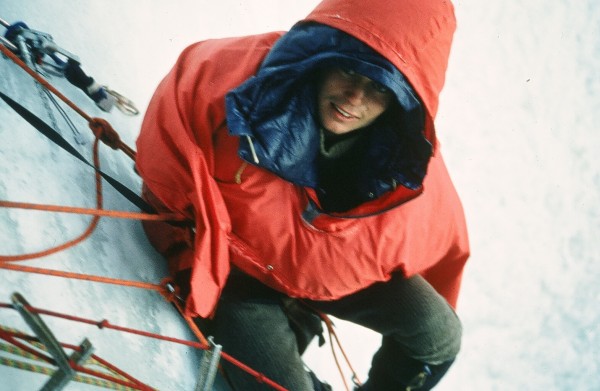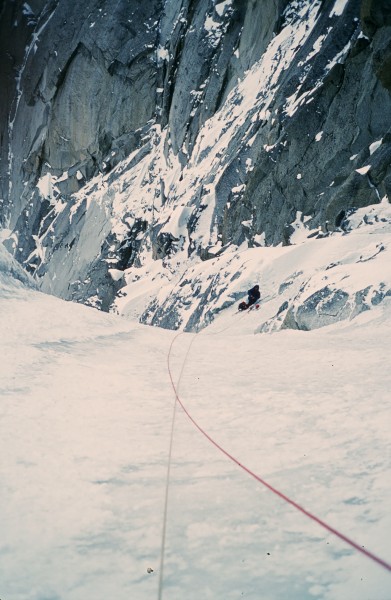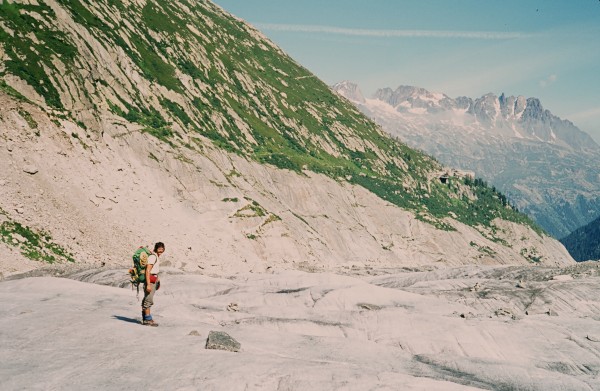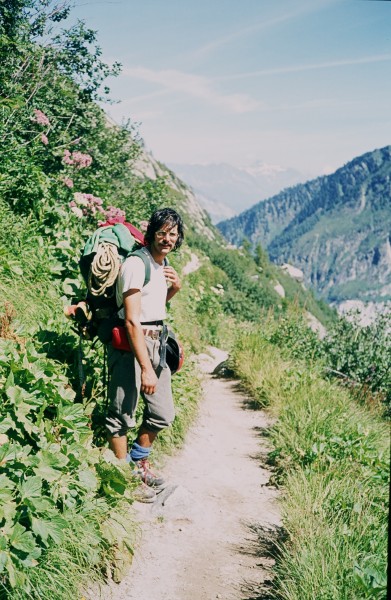Trip Report
Dru Couloir Direct : First Ascent 1977, Tobin Sorenson and Rick Accomazzo
|
Thursday April 19, 2012 12:38am
|
|
We were ecstatic when we reached the Breche (the snowy saddle between the Grand and Petit Drus), and I made Tobin stop, so I could get the camera out and snap a shot. This image, emerging from the dark depths of the couloir, is my favorite memory of Tobin, who died while soloing three years later.
We knew that the climb was a plum and we couldn’t believe that we had actually pulled it off. It was especially surprising for Tobin, who hadn’t climbed a single pitch, rock or ice, for the first 8 months of the year due to surgeries on his shoulders. His very first climb in the Alps was 700 meters of steep ice, a new line on one of Europe’s most fabled and striking peaks, and Tobin’s smile had the look of the cat who ate the canary.
There was still some excitement to come when we made a series of rappels down the sunny south side of the Dru. A ways down, Tobin went first and I was waiting to hear “Off”, so I could start down. I waited a decent interval, but there was only silence. I leaned over and yelled down to him but still nothing. I yelled again louder, but no answer. The thought flashed through my mind: he’s gone off the end of the rope. I yelled frantically now. Finally, I grabbed the rope and started down, calling as I went.
Halfway down, Tobin finally responded and I was able to inhale again. When I got to him, he sheepishly told me what had happened: he had plopped down on the ledge and promptly fallen asleep. His amazing, off the couch effort had finally caught up with him.
Tobin lower on the descent
Recently published photos and videos of the Direct brought back vivid memories of this route, and prompted me to revisit the story of the first ascent. This was something ST’s official historian, Steve Grossman, had asked me to do a while ago, so here, for the ST record, is the story.
Jon Griffith’s beautiful photos and account of a recent ascent, featuring modern, athletic dry tooling are here:
http://www.alpineexposures.com/blogs/chamonix-conditions/5916109-dru-north-couloir-direct
Video is here: http://vimeo.com/40253797
I will dig out my old magazines and scan and post later the original article I wrote for Climbing magazine back in 1978, as well as the short write up that Tobin submitted to the American Alpine Journal. John Long and Dean Fidelman's Stonemaster book includes an edited version of the Climbing article.
The pictures from the ascent are below, taken with a little Rollei camera that I bought for this trip.
Bivouac below the face. We approached via the Grand Montet lift and were delayed waiting for a storm to clear before starting up.
After the first third of the route which consisted of 60 degree ice, we reached the first pitch of the Direct: Fine, plastic ice and my lead.
First pitch higher up. We used 9 mil ropes, climbed on one and hauled with the other to avoid climbing with packs.
Around the second or third pitch.
Above the last pitch crux of the Direct and into the upper couloir
Upper couloir
Bivuoac in the upper couloir, near what is now called the S curve
Looking down at the bivuoac site
Reaching Montenverts.
On the trail: happy campers.
Looking at Griffith’s photos, the differences between 1977 and today are remarkable. 1977 was a year of record snowfall and we had thick and plastic ice for much of the route, with a couple of short aid sections.
But one thing has not changed: the last pitch of the Direct, before it meets the upper couloir, was the crux , then and now. I started leading that pitch with Tobin belaying on a stance below the big corner, about the same place indicated in the recent photos. I got to Steve’s last gear, where he had lowered off a couple of days before, a tied off ice screw with a carabiner on it.
Above that was a 4 inch wide strip of ice that filled the corner flush to the edges of the crack. Approximately thirty higher, at the top of the corner, right where Huey battles in the video to get picks into the thin ice patch, there was a gigantic overhang of rotten, black-stained snow and ice. It overhung at least 10 feet out from the rock and it looked nightmarish and absolutely unclimbable.
So I looked for another way. The right wall was featureless, but it seemed like there might be a weakness on the left wall: a thin crack system parallel to the corner. This crack system is prominent in the recent photos, but back then it was concealed under a sheet of ice, an inch or two thick. There was a one or two foot foot wide ledge out on that left wall and it looked like I might be able to get to it, stand up on it, and see how it looked from there.
So, I tension traversed out from the screw, got to the ledge, and pretty soon I was committed to either standing up on that ledge or taking a nasty fall back into the corner straight onto Steve’s tied off screw, which was about as solid as it sounds.
I was truly gripped when I stood up on that ledge. It is dead vertical there and I was able to mantle/balance up onto it, and get the picks of the Terrordactyls into the verglas. It was time to get some gear in, but there was nothing to be seen. I held on with one pick and chipped the ice off around the crack with the other Terror. A thin crack appeared and I managed to bang a pin in and lowered off to clean, since I had used up all of our meager gear. This was strenuous because I had to swing back into the corner to retrieve each piece. When I got down, Tobin took over the rest of the pitch of vertical, thin ice, which got us around the ice overhang and within reach of the easier angled, upper couloir.
On the hike down after finishing the rappels, we passed some French climbers going up and one asked us what route we had done. “Couloir Nord Est” I replied, using my best high school French. I proceeded down and at a switchback happened to glance back up the trail at them. They hadn’t moved and were still staring, so I gave them a big smile, like Tobin’s at the Breche.
| |
Trip Report Views: 14,889 |
 Rick A
Rick A
|
 |
About the Author
Rick A is a climber from Boulder, Colorado. |
Comments
 john hansen
john hansen
climber
|
 |
|
|
Apr 19, 2012 - 12:46am PT
|
This is why I still check in here now and then,, thanks.
|
|
 Russ Walling
Russ Walling
Social climber
from Poofters Froth, Wyoming
|
 |
|
|
Apr 19, 2012 - 12:51am PT
|
Good stuff!
|
|
 Todd Eastman
Todd Eastman
Social climber
Putney, VT
|
 |
|
|
Apr 19, 2012 - 12:57am PT
|
Rick, nice article and pics. Quite a season!
|
|
 RDB
RDB
Social climber
Great Basin
|
 |
|
|
Apr 19, 2012 - 01:08am PT
|
Great story Rick. Thanks for sharing.
|
|
 Ed Hartouni
Ed Hartouni
Trad climber
Livermore, CA
|
 |
|
|
Apr 19, 2012 - 01:08am PT
|
Mountain 58 p.16
Petit and Grand Dru:
N.E. Couloir
A direct start has been added to the couloir by American climbers. First, Steve Shea and Jack Roberts mistakenly climbed the lower ice runnel direct, where the Cecchinel/Jager Route veers off to climb rock pitches on the left. The pair reached a point just below the wide upper couloir, but here a storm broke and they were forced to retreat. A few days later, this direct line (with a slight variation) was repeated by Rick Accomazzo and Tobin Sorenson, who then continued up the whole couloir. The direct climb involves five pitches of very steep ice, with several vertical sections, a 30ft. overhanging section and a short section of A2.
|
|
 bergbryce
bergbryce
climber
East Bay, CA
|
 |
|
|
Apr 19, 2012 - 01:13am PT
|
Great piece of history.
Thanks.
|
|
 Jon Griffith
Jon Griffith
Mountain climber
Chamonix
|
 |
|
|
Apr 19, 2012 - 05:22am PT
|
Nice Rick, Glad it brought back some good memories. Awesome article
jon
|
|
 steve shea
steve shea
climber
|
 |
|
|
Apr 19, 2012 - 01:50pm PT
|
Beautiful Rick. I was hoping for a photo of the ice bulge but I know how busy you were. Our attempt ended just above the ice bulge. I was able to climb it but at my limit the whole time. I just remember hacking away making the overhang worse. I had climbed Bridalveil Falls with Gordon Smith earlier in pretty funky conditions, this seemed similar to the crux second pitch so doable. I hacked away so much ice that I made a wall to chimney agaisnt with by back, rightside in, pushing against the left wall with my feet. After what seemed like an hour to go 15' I finally got a look int the upper couloir. I bellied up over onto easier ground and managed a not very secure belay. The ice was thin and trending left. I called down to Jack to come up. I was totally spent physically and mentally and looking forward to just belaying for a while. It was the morning of our fourth day out. One day we did not climb but sat out the storm due to lightning. Some how it seemed safer to stay stll and brew up. The storm was actually diminishing and I felt we had the route. Then after a lot of yelling back and forth Jack finally relayed up the news that Mugs and Trover wanted to retreat. Each team had 90m ropes but not enough gear to go it alone on a descent so we had to stay together. This turn of events tore me up. After the effort and repeated assurances of commitment to keep going, I was devastated. Jack and I had lead the whole route and were still keen on finishing but no way could we abandon those guys, what to do? The only thing was to go down. I was placing lousy ice screws in almost non existant ice and stepping down on slings tied together for etriers and back cleaning as I went. There was no hope of downclimbing on tools at least in the state I was in. I left another screw I guess Rick did not see right at the edge and lowered down to place asomewhat secure screw, tied off and pulled the rope. I lowered to Jack on the gear Rick found. The four of us rapped off using all of our gear to reach the bottom. We made it back to town to find that we were out in a very serious storm which affected the whole area from Cham to Zermatt. Many people had died or were still missing. Jack and I found our own obit on the wall at the Place de l'Eglise/Compagnie de Guides. The only photos I have are in my mind's eye, thanks Rick
|
|
 Johnny K.
Johnny K.
climber
|
 |
|
|
Apr 19, 2012 - 10:07am PT
|
Thank you for the beautiful post,so much respect and appreciation!
|
|
 steve shea
steve shea
climber
|
 |
|
|
Apr 19, 2012 - 10:14am PT
|
BTW it is interesting that Cecchinel also avoided another obvious and direct line on the Cecchinel/Nominee sp; on the Eckpfeiler/Grand Pilier d'Angle. Right at the point of the pendulum there are two very steep but direct lines to the top.
|
|
 philo
philo
climber
|
 |
|
|
Apr 19, 2012 - 10:14am PT
|
Rick, I remember when you guys did that route. Bloody wicked! Those pics give me shivers.
|
|
 Steve Grossman
Steve Grossman
Trad climber
Seattle, WA
|
 |
|
|
Apr 19, 2012 - 10:37am PT
|
Ricky- Thanks for taking the time to put this TR together.
Outstanding effort with the gear du jour and nice hit of Tobin which is always welcome and satisfying.
Proudest new ice route done by any American team at the time? I suspect so especially on the celebrated Dru.
Steve- Declared dead that fast?!? Not exactly a cheery business is guiding...
|
|
 bmacd
bmacd
Trad climber
100% Canadian
|
 |
|
|
Apr 19, 2012 - 10:36am PT
|
American Legends
|
|
 GrahamJ
GrahamJ
climber
In the rain
|
 |
|
|
Apr 19, 2012 - 06:28pm PT
|
very cool. Reading about climbs like this is awesome. Nice work guys.
|
|
 Steve Grossman
Steve Grossman
Trad climber
Seattle, WA
|
 |
|
|
Apr 19, 2012 - 10:14pm PT
|
I went back through my scanned material and found this Dru Couloir shot from the History of World Mountaineering.
A little background on the original Dru Couloir ascent from Stefano Ardito's luscious Mont Blanc.
Cecchinel on the left and Jager the right.
|
|
 Crimpergirl
Crimpergirl
Sport climber
Boulder, Colorado!
|
 |
|
|
Apr 19, 2012 - 09:16pm PT
|
Love it! Thanks!
|
|
 zBrown
zBrown
Ice climber
|
 |
|
|
Apr 19, 2012 - 09:33pm PT
|
Excellent! Thanks for sharing this.
|
|
 Rick A
Rick A
climber
Boulder, Colorado
|
 |
|
Author's Reply
|
Apr 29, 2012 - 12:34pm PT
|
I finally found and scanned the original, 1978 Climbing article.
|
|
 Jan
Jan
Mountain climber
Colorado & Nepal
|
 |
|
|
Apr 29, 2012 - 12:47pm PT
|
Thank you!
I love reading about climbs in the Chamonix region, most of which I've seen
only from a telepherique or a hut.
Trip reports are so much more interesting.
|
|
 johntp
johntp
Trad climber
Punter, Little Rock
|
 |
|
|
Apr 29, 2012 - 12:58pm PT
|
Thanks Rick. It always amazes me how the stonemasters went beyond yosemite and tahquitz to the alps.
|
|
 David Wilson
David Wilson
climber
CA
|
 |
|
|
Apr 29, 2012 - 01:33pm PT
|
impressive Rick - looks like that route is still full value today. i can't help thinking of that north face of alberta, just a few years later.
|
|
 Rick A
Rick A
climber
Boulder, Colorado
|
 |
|
Author's Reply
|
Apr 29, 2012 - 05:40pm PT
|
Jan-
I learned from the Sacherer thread that he was probably in and around Chamonix during the summer of 1977.
Who knows, we might have crossed paths with him without knowing it. I did meet a couple of physicists from Cern on the Bonnati pillar in 1976, and they certainly must have known him.
It was a very small climbing world in those days.
Rick
|
|
 RDB
RDB
Social climber
Great Basin
|
 |
|
|
Apr 29, 2012 - 06:25pm PT
|
"It was a very small climbing world in those days."
Truth is for these kinds of routes it is still a very small world.
|
|
 Mimi
Mimi
climber
|
 |
|
|
Apr 29, 2012 - 06:46pm PT
|
Amazing feat, Ricky! Thanks for posting up. You too, Steve. True adventure.
|
|
 tahoe tom
tahoe tom
Trad climber
camas wa and incline village nevada
|
 |
|
|
Apr 30, 2012 - 02:39am PT
|
thankyou for sharing. I always looked up to climbers like you and Tobin.
|
|
 Rick A
Rick A
climber
Boulder, Colorado
|
 |
|
Author's Reply
|
May 5, 2012 - 10:14am PT
|
As Steve points out, the original Dru Couloir route was done by Cechinel and Jager during the winter, about three years earlier. The face can be roughly divided into thirds, and it is the middle third where the Direct diverges from the original. In this middle section, the original route is about 150 feet left of the Direct. The Direct is the better line because it follows the uninterrupted flow of the couloir for the whole 700 meters.
Before we started up, I found a hand written description of the original climb in the route book kept in the Chamonix Bureau des Guides. It is likely that this description was authored by Cechinel and Jager after the first ascent.
I recently found pressed into an old guidebook that description, which I translated and took with us on the route. You can't tell from the scan, but it's copied onto a receipt from the Snell Field caretaker who collected the camping fees.
|
|
 survival
survival
Big Wall climber
Terrapin Station
|
 |
Wow!! How did I miss this before?
So cool, and BADASS!! Thanks for bringing the goods!
|
|
 steve shea
steve shea
climber
|
 |
One correction. Our climb of the Direct variant was not inadvertant. It was intentional. The following summer, 78', I got to climb the Cecchinel/Nominee on the Grand Pilier d'Angle with Chamonix guide and climbing pioneer Joel Coqueniot. We started up the Cecchinel/Nominee and at the point of the grand traverse right we had an indentical decision to make. Above were two beautiful shallow couloirs with perfect water ice. We chose the one on the left and finished on top of the Bonaitti/Gobi then up the Peuterey to the Monte Bianco. Strangely similar to the Dru decision involving the same first acensionist, Cecchinel. When presented wih perfect ice going straight up or traversing on rock we chose the ice. It turns out the gully on the right was the Fowler? Brit finish. Our route and was unclimbed and Joel wrote it up at the Meteo. Also sad to think that Tobin, Mugs and Jack are gone now. Half of the original Americans to pioneer this line, on the Dru that is. SS
|
|
 RDB
RDB
Social climber
Great Basin
|
 |
With all due respect (which is a lot!) for the guys who did all this. Thought it worth a little perspective. For everyone that was climbing at the time ice climbing changed radically in just a few seasons with the use of better tools.
"We were sheltered and safe standing at the foot of the Cecchinel/Nomine’, a route first climbed in 1971 when I was twelve. Walter Cecchinel and Georges Nomine’ opened the route using the new, and controversial, “piolet traction” technique - planting the picks of an ice axe in each hand and pulling up on it via a wrist loop."
Barry Blanchard, 2000
1st ascent of the Cecchinel/Nomine, GPA, Sept 1971
Three bivies on the Dru winter, Dec'73, from the helicopter
By the mid '70s things had changed a lot. Terros becoming easily available being one of them. Just as Nomics and its clone, the Fusion Jesse was using in Jon's excellent video have changed things once again.
Dec '73 to August of '77 was several light years into the future for gear. The climbers doing these sorts of routes changed little. The gear changed a lot.
|
|
 steve shea
steve shea
climber
|
 |
I can certainly understand and relate to their route decisions. I too used to use hinged crampons and Stubai Walliners before getting the new stuff. The Dru is especially easy to see their route rationale. However on the Pilier d'Angle the route goes to easier ground with the rock traverse but also directly under a giant hanging serac on the upper snowfield. The Boivin/Valencant variant was a shooting gallery and almost directly under. Of course this was back when it used to snow. I don't know what it looks like now. On our approach under the Brenva Face there was sustained avalanche activity. That played into our decision to go direct and leave the original route. Total respect for Cecchinel. Also to Patrick Gabbarou. We repeated some of his routes and were always impressed. It was the new tools that gave us the "vehicle" to climb that ice which takes nothing from what the first ascensionists did; just different. In retrospect I think I got as much or more satisfaction on the classics rather than the more difficult stuff. My favorite part of European alpine climbing was always the history.
|
|
 Todd Eastman
Todd Eastman
Social climber
Putney, VT
|
 |
We didn't really know it at first but the American climbers traveling over to Cham during the mid and late 1970s were climbing ice at a higher level than the French. The Brits were also playing the ice game at a high standard.
|
|
 steve shea
steve shea
climber
|
 |
To what Todd posted, absolutely correct. Back in the mid 70's none of us had traveled much outside our own regions. In fall of 76' Gordon Smith showed up in Aspen on a mission to climb ice. We teamed up and did the second ascent of Bridalveil Falls in Telluride. We cruised it. It was the classic provincial thinking that prevailed, we could not possibly measure up. That's why so many early 5.10+s are actually 5.11. One tended to rate relative to one's local experience. There was always reluctance to go a grade higher. Plus we are country bumpkins, we can't be any good. Well thanks to Jeff Lowe we learned the "monkeyhang", sort of the "Leavitation" of ice climbing. We applied what we learned on the waterfalls of Colorado to alpine routes in Canada and Chamonix and got a pleasant surprise.
|
|
 Todd Eastman
Todd Eastman
Social climber
Putney, VT
|
 |
Bruce, the same gear was also available in Europe. The big difference was that we had been looking at ice climbing as an end for itself, a substitute for rock climbing during the cold months, and perhaps as a valuable tool for alpine climbing. We had sought out any and all possible ice covered surfaces for ice climbing in the Northeastern US and Steve and the crew in Colorado was doing the same thing. This was all happening as the Canadian ice scene was going on in a similar fashion in Quebec and out West.
For many of us Easterners, we could find ice to boulder and climb on really near home and spent tons of time honing our skills, because we figured we sucked.
The big difference between what was going on in North America was that we were digging ice climbing for its own sake while the guys in Cham and maybe throughout the Alps were still treating it as an mere variant of the alpine climbing game.
What Steve said regarding the hick mentality that sort of said, "well if we can do this it can't be that hard" was strongly in play, and maybe enhanced with a dash of sandbaggery common to out home bases.
As for the tools in the pics, the French developed tools specifically for climbing winter ice in Cham and those are what are pictured. The winter ice in Cham has a consistency that made Terrors useless and broke many Chouinard picks. Simond tools had a carefully designed lesser droop than the Chouinards and were made with a better steel for the task. Charlet followed suit with some innovative designs the worked superbly in the Cham area at that time.
|
|
 mastadon
mastadon
Trad climber
crack addict
|
 |
Rick-do you keep in contact with Tobin's mom? I met her in the Valley in the early 70's- 73 or 74, I think. I think it was when Tobin and Graham were up on The Prow (they got rescued from the top due to a horrendous storm). She was really sweet. I remember how young and vibrant and beautiful she was and, oh my, she was oh so proud of Tobin. She went on and on about Tobin. It must have just about killed her when Tobin died. I remember thinking about her when I heard about his accident. Parents never recover from things like that.....
|
|
 RDB
RDB
Social climber
Great Basin
|
 |
The axe on the right was one used on the 1st ascent of the Dru.
There were some radically dropped Charlet, Grivel and Stubia (and the Brit's Curver) tools previous that faired no better than the Chouinard tools for durability.
All basically something more akin to this Mtn Technology tool on top of the Chouinard Piolet shown here. I'm to lazy to get into the gear room for more pictures.
Great story Jack R. would relate about going to the Charlet factory and getting his pick tip rebuilt while he waited. The first really successful Euro tool for the local conditions was the Chacal in '78 or '79 iirc. Gordon Smith had the first which he talks about here on the Taco. But basically an over grown Terro. The Terro or its clone the Roosterhead was involved in a lot of these early climbs. Just as they were on many of the cutting edge climbs back in Canada and the US between '74 and '78 when the Chacal showed up.
New tools opened up a lot of new ice...just as Friends did on rock a bit later on.
A very early Chacal
The Simond list from 1979
|
|
 steve shea
steve shea
climber
|
 |
Todd was in the center of ice climbing in the US. The New England states has more potential ice close at hand than any where. In any condition you could want. We used to say Denali was good training for the Tetons in winter, and the Tetons were good training for the Presidentials. Back in the early ice days our only real brothers in arms were in the NE. There is some desperate climbing in some of worst weather on the planet...fertile ground to hone ice skills. As Todd says the euros were not climbing waterfalls. Except for one maybe, Gabbarou. Jackson and I had custom curved Gabbarou Cascades made at the Charlet foundry while we waited. Georges Bettembourg was a distant relative and set it up for us. We would typically take three tools; a 70cm for snow and travel but curved enough to use on steep, the Charlet with adze or hammer and slightly lengthened Terrors which were better than the shorties. We also pretty much took the same rack 6 pins, 6 screws and 6 nuts with some variation according to the route but that was the basic. Roosterheads and Hummingbirds were junk. Terrors were also great on rock. Yes, we dry tooled back then. Lou Dawson came up with the idea to go bouldering with ice gear. There was usually enough snow that if you peeled no big deal. Terrors were the best on rock. Don't forget John Bouchard of NH. He was an alpine beast and tore it up over there long before we got there. His solo of the NF Grand Charmoz got the attention of the French. I think he was the first American ever to be accepted to the Aspirant Guides UIAA program in Chamonix. They made it extremely difficult on him and were envious. Not only was he a brilliant alpinist snagging their best routes, he also had a French girlfriend, Titune. I think she was the daughter of the mayor. I can remember John telling us stories of the French disdain for him. He laughed it off. BTW to Todd's main point, we were cilmbing very steep ice from the beginning with whatever tool. We were on waterfalls, and roadcuts and seeps that by their very nature were more steep than alpine ice. We did not know any different. We had no frame of reference. That was the ice we had so you climbed it. So take that background to the alps, scope a giant 70 degree alpine face, almost every route extant avoided the steepest ice. Americans and Brits would be inexorably drawn to the steepest lines. It is what we did...that was ice climbing.
|
|
 steve shea
steve shea
climber
|
 |
Bruce, yes. The first time I visited the Lauterbrunnen Valley not one major waterfall had been done. That was 77'. We were lickin' our chops but had other business. I vowed to return but never made it. It became an ice climbing destination back when winter happened. BTW Bonaitti considered piolet traction aid.
|
|
 SCseagoat
SCseagoat
Trad climber
Santa Cruz
|
 |
Very much enjoyed the TR and and the additional comments and add ons. How is it we blinked....and suddenly those years seem so far away, but feel like yesterday. Wonderful stuff, thanks
Susan
|
|
 Steve Grossman
Steve Grossman
Trad climber
Seattle, WA
|
 |
This may have been mentioned already but what crampons were Cecchinel and Jager wearing on their Dru Couloir ascent?
I can't quite make it out in RDB's photo.
|
|
 steve shea
steve shea
climber
|
 |
Steve, I don't know for sure. The photo RDB posted show what looks to be non hinged. They look very similar to the early Chouinards that were light in color. Sort of cad plated looking. They were soft and broke easily. The black ones were much better. The boots do not look to be flexing at all and he's got what looks like a vapor barrier over his gaitors.
|
|
 RDB
RDB
Social climber
Great Basin
|
 |
The picture above is on the 1st ascent of the Cecchinel/Nomine, GPA, Sept 1971 not the Dru in 1973.
The Dru crampon of '73 and likely the crampon used by Cecchinel/Nomine in'71 was the rigid Simond Makalu. Chromoly, hard chromed finish, introduced in '72. Much like the later SMC rigid.
Cecchinel in a later version that was hinged much like the later Chouinard hinged. Almost the equal to the earlier rigids on a rigid leather boot. The photos I have been posting are from the Jerome Blanc-Gras and Manu Ibarra's new ice climbing book "Glaces" published by Blue Ice. Their book offers an interesting and detailed perspective on European Ice climbing history and techniques with interviews from many of the early players.
|
|
 RDB
RDB
Social climber
Great Basin
|
 |
Be fun to have Gordon Smith back chatting about his thoughts on the time. I wish I had gotten Jack Roberts to write about it more as well. He left my place with a couple of the old Mt. mags with the original reports that were jogging his memory of the events discussed here. I generally bug Bouchard a couple of times a year for somehistorical tidbit. Steve's right though Bouchard made a huge impression in Cham and left a lasting impression in the US that we still see fruit from.
A little couple of years later ('80) later but a definate connection to NA skills, Canadian Dwayne Congdon is still alive and working. His and John Lauchlan's trip to Cham was another bench mark.
http://www.johnlauchlanaward.com/pages/Main%20Pages/About%20John.htm
http://www.johnlauchlanaward.com/pages/A%20parting%20Gift.htm
Some from Gordon Smith here:
http://www.ukclimbing.com/articles/page.php?id=990
Still Rick's and Steve's, along with the rest.."magical alpine season" is something the current generation only aspires too. That is a pretty amazing legacy in my book!
|
|
 Rick A
Rick A
climber
Boulder, Colorado
|
 |
|
Author's Reply
|
May 9, 2012 - 10:12am PT
|
Regarding the rapid development of ice tools and techniques in the early 70s, Dane provides some great perspective.
But if you look at the example of Tobin Sorenson, you realize that improved gear is an inadequate explanation for his successes. Tobin's string of ascents in 1977 of the most difficult ice and mixed routes in the Alps, including the Dru Couloir Direct, a new ice route on the Dent du Requin with ST's own Todd Eastman, the Eiger Direct (Harlin) with Alex Macintyre, and a new mixed route on the Grand Jorasses "Scala di Seta" with Gordon Smith, were more about his attitude and skill than his gear. Tobin used a 1973-75 vintage Chouinard axe and ice hammer, and flexible Salewa crampons that year.
Here is Grand Jorasses historian and ST contributor, Luca Signorelli's updated description of Scala di Seta.
“Scala di Seta” (Smith/Sorenson, 1977, , ED+, VI+ and A0, 90°, 1200m) Until 2008, the story of this route was one of the greatest "disappearing acts" of the history of alpine mountaineering. For 30 years, it was believed that Smith and Sorenson (two underrated but pivotal figures of the hard climbing scene of the late '70) had "just" made the first summer ascent (and third or second repeat) of the "Gousseault". But in autumn 2008 Smith discovered, under completely fortuitous circumstances, that they had, unknowingly, opened one of the hardest, longest and boldest mixed line of the NF of the Jorasses. The route shares only 30% of the Gosseault, as it starts on the (alleged) "Rolling Stone" ramp to the R of the 1971/1973 start, reaches the Gousseault at the beginning of the First Ramp, and deviates somewhere through the Second, taking a detour to the R. The spectacularly nasty crux is on the L of the "Red Tower".
|
|
 steve shea
steve shea
climber
|
 |
"It is a poor workman who blames his tools" Tobin might be the best climber to come from the US. One can only speculate on what he might have accomplished, but it would have been cutting edge.
|
|
 Rick A
Rick A
climber
Boulder, Colorado
|
 |
|
Author's Reply
|
May 9, 2012 - 10:06am PT
|
Bruce-The beginning of the Climbing article above recounts how Tobin was secretly evangelizing in communist Bulgaria just before this climb. He was a remarkable character, both in the mountains and off.
The snow and ice overhang at the top of the last pitch of the Direct, that was such an obstacle in 1977, is nowhere to be seen in Griffith's photos from this year. However, you can get a sense of what it looked like from this video of a 2008 ascent, when Slovenian climbers, Andrej Grmovsek,Marko Lukic, Tina Di Batista and Tomaz Jakofcic, did the first free ascent of the Direct.
http://www.youtube.com/watch?v=OIuKlE5LA3k
If you stop the video at :37, you can see the leader climbing the crack system (sheathed in ice in 1977) that Tobin and I used to avoid the enormous, inverted, frozen wedding cake that capped the corner in 1977. Earlier in the video at :22, it shows a different leader (from the other rope perhaps?) tackling the overhang directly. The obstacle in 1977 was at least twice as big as what is seen in the 2008 video, and not nearly as solid, looking from my vantage point to be mainly rotten snow.
|
|
 Steve Grossman
Steve Grossman
Trad climber
Seattle, WA
|
 |
Dane- Have you emailed Gordon lately?
Ricky- Could you transcribe that hand written route description when you have time?
|
|
 RDB
RDB
Social climber
Great Basin
|
 |
Steve, I have not. Been a couple of years now.
Tools? Messner did his route on le Droites with ice daggers, solo in '69. Tobin did some amazingly hard climbing with his alpine hammer and a piolet.
Tobin on the Harlin @ M8+ (5.11+/5.12-)
Neither were the norm. Hard not to acknowledge that fact. There are comments here offering support for both sides of the "tool" discussion.
Steve's mention of "dry tooling" in the (mid?) '70s is the earliest reference I have seen of intentionally using ice tools on rock. From my memory Gordon's account of Tobin" and his ascent on the Grand Jorasses clearly thought doing so (pulling tools on rock) was aid.
I think that mind set (intentional use of an ice tool on rock) is very signifigant in the history of alpine climbing.
"Lou Dawson came up with the idea to go bouldering with ice gear. There was usually enough snow that if you peeled no big deal. Terrors were the best on rock."
Question for Steve?
"In fall of 76' Gordon Smith showed up in Aspen on a mission to climb ice. We teamed up and did the second ascent of Bridalveil Falls in Telluride. We cruised it" "...in pretty funky conditions"
Likely one of the hardest pieces of ice climbed anywhere in the world at the time. Curious what you guys used for tools on Bridalveil?
|
|
 steve shea
steve shea
climber
|
 |
Gordon came to Aspen in Dec. 76. Bridalveil was first on his list. When he suggested it I was keen to go. Weis and Lowe first did it in 72' I think. Closures and bad conditions and reputation kept us away. It had quite a reputation here and in Britain. We got to Telluride and found conditions so lean that we could drive my old Saab right to the base. It was in but very thin. We flipped for the lead. So I ended up with the crux second pitch. It was extremely overhung, cauliflowered and chandeliered. Similar to the ice bulge we've been discussing on the Dru thread. You really could not climb it normally, it was linked pullups hooking the cauliflowered holes. God bless terrors. We each used two terrors, short ones. Yes we climbed a lot of rock/mixed in those days with ice gear. It just happened out of neccessity. Lou came up with the idea to go bouldering to hone our skills. We would practice on the Patrol boulder right at the Independence Pass barricade. Lou did some serious dry tooling on the first ascent of one of the Hidden Falls routes in Glenwood Canyon. On Pyramid NF and Capitol NF and really anywhere we just left our stuff on. It was too time consuming to keep changing back and forth. We found we could face climb better once you got used to the different leverage with crampons. And Terrors could hook anything. The rock is why we sh#t canned Hummingbirds, once the tube was choked off from hitting rock they were useless plus they broke. Roosterheads worked but too maleable and bent easily. The custom Charlets we had were very good on rock. I've always worked in the ski industry and would use light weight diamond stones taped to a sling for quick touch ups enroute. I heard from Gordon last fall through ST. He wanted Bridalveil photos. I'm bad with a camera just extra crap.
|
|
 JEleazarian
JEleazarian
Trad climber
Fresno CA
|
 |
What a great TR! I never got to know Tobin, but certainly admired him.
I still have my first generation Chouinard rigid crampons, that perfectly fit my Galibier Peutereys, and I even still use both on occasion. I think people forget how revolutionary the curved pick on the ice axe was. I know that Hamish MacInnes was experimenting with ice hammers, but I don't recall any ice axe with anything but a straight pick before the Chouinard-Frost Piolet came out.
John
|
|
 Rick A
Rick A
climber
Boulder, Colorado
|
 |
|
Author's Reply
|
May 12, 2012 - 12:07pm PT
|
Steve- Here is the text of the description for the original Dru Couloir route:
Approach the bottom of the couloir via 8 rope lengths of 55-60 degree snow & ice
Continue in a crack system coming out of the col for 2 rope lengths (IV, verglass, middle difficulty rock) then continue, tending to the right in order to join the rock wall at the bottom of a fine crack (blades) several meters to the left of a small dihedral (V then VI diff. placements covered with ice)
At this point, one finds himself 50 m. to the left of the main couloir axis. Climb this fine crack on aid (15-20 pins) easy at first then ending in a corner of V and AI. Continue on the right for 20 m.(pin in place, biv. on the left on slab)
At the level of piton, traverse right in order to gain a dihedral crack tending toward the right. (AI,V 8-10 pins).Gain a platform and traverse several meters to the right, then climb a chimney crack which permits you to reach the bottom of the main couloir (IV,IV+).
Then one climbs the right side of the couloir for 3 pitches 65 degrees.Traverse the couloir under the first bulge in order to take the outside of the (S) formed by the couloir. Continue to the left for 2 pitches (75 degrees). At the level of the Leseur traverse, under the 2nd bulge, take the right side 80 degrees and continue towards the col. 75 degrees 6 pitches.
All belays pins.
Jon Griffith also climbed the original route in 2011. The "fine crack (blades)" is apparently now called the Nominee Crack. Story and pictures of that climb here:
http://www.alpineexposures.com/blogs/chamonix-conditions/2702932-north-couloir-les-drus
|
|
 Steve Grossman
Steve Grossman
Trad climber
Seattle, WA
|
 |
|
|
May 12, 2012 - 11:58am PT
|
Thanks Rick!
|
|
 BMcC
BMcC
Trad climber
Livermore
|
 |
|
|
May 13, 2012 - 12:44pm PT
|
Great TR and thread! Awesome accomplishments and history.
|
|
 Rick A
Rick A
climber
Boulder, Colorado
|
 |
|
Author's Reply
|
May 26, 2012 - 03:02pm PT
|
That picture of Tobin on the Eiger Direct shows a foam pad in his pack. This reminded me that we had foam pads on the Dru also, but Tobin dropped his at the last bivouac. He laughed at this misfortune and he was his usual, cheerful self during that uncomfortable night.
On the discussion of early dry tooling, I am sure it was common for short sections well before the seventies, especially in a place like Scotland. I recall twisting the tip of the Chouinard tools into cracks on occasion and hooking them on others. However, on rock sections, we tended to holster the tools, take off the dachsteins (we had them attached to our wrists with small cords for this purpose) and use bare hands on rock while edging with the crampons. Tobin became a master of alpine rock climbing by that method, as can be seen from that Eiger photo.
And he pushed his limits on mixed, just like he did on rock. I expect that Gordon had never seen anything like it when Tobin took 50 foot leader falls on the Scala di Seta. I remember Tobin saying that he could easily climb 5.10 rock in crampons after he came back from Europe in 1978.
Jeff Lowe’s Metanoia route on the Eiger, which is the subject of the film that is under production, features an overhanging rock climbing section that, I understand, has repulsed some modern dry tooling attempts by excellent climbers. Jeff told me that he used to carry a whisk broom and used it to brush snow off the holds in that section. I think he employed mountain boots without crampons there, but I’m not sure of that.
|
|
 Marlow
Marlow
Sport climber
OSLO
|
 |
Phenomenal TR and alpine climbing history thread...
|
|
 kunlun_shan
kunlun_shan
Mountain climber
SF, CA
|
 |
|
|
Nov 15, 2014 - 01:13pm PT
|
Wow! Only on ST.
|
|
 Rick A
Rick A
climber
Boulder, Colorado
|
 |
|
Author's Reply
|
Nov 20, 2014 - 06:37am PT
|
As mentioned in the Les Droites thread, ice conditions in Chamonix are apparently better than they have been in years.
Here is a blog by an Italian guide that describes a number of recent Chamonix climbs, including the original Dru Couloir route. The Dru Couloir account includes a photo looking up at two climbers on the Direct.
http://philippangelo.blogspot.com/2014/11/les-droites-colton-brooks-tacul.html
If you compare that photo with Jon Griffith’s video of Jesse Huey and Maury Birdwell’s climb a couple of years ago, ice conditions are markedly better this year.
http://vimeo.com/40253797
|
|
 Larry Nelson
Larry Nelson
Social climber
|
 |
|
|
May 31, 2016 - 10:32pm PT
|
Bump for some great climbing history
|
|
 Charlie D.
Charlie D.
Trad climber
Western Slope, Tahoe Sierra
|
 |
Fantastic Rick thanks! Thanks for the bump, the things we miss!!!
|
|
 FRUMY
FRUMY
Trad climber
Bishop,CA
|
 |
Thanks!
|
|
 Todd Eastman
Todd Eastman
Social climber
Putney, VT
|
 |
Rick, I can't help but think how lucky we all were to be where we were in those years and to have the friends we did to climb with.
We all showed up in Europe with local skills and decided to play hard on someone else's turf. Great fun then and great memories now.
Thanks for all your work at telling the stories.
|
|
|
 |
 |
Recent Trip Reports
- The Kohala Ditch Trail: 36ish hrs on foot... to and from the headwaters. [5 of 5]
May 31, 2019; 11:57pm
- A Winter Traverse of the California section of the PCT Part 8
May 31, 2019; 11:18pm
- Supertopo,A trip report for posterity
May 31, 2019; 11:00pm
- Balch Fest 2013. Two Days in and Around and On The Flake. The Official Trip Report
May 31, 2019; 10:57pm
- TR: My visit to the Canoe
May 31, 2019; 10:24pm
- Death, Alpine Climbing, The Shield on El Cap
May 31, 2019; 4:07pm
- Andy Nisbet (1953-2019)
May 31, 2019; 2:11pm
- Drama on Baboquivari Peak
May 31, 2019; 1:19pm
- Joffre + The Aemmer Couloir: ski descents come unexpected catharsis [part 2]
May 31, 2019; 7:45am
- Lost To The Sea, by Disaster Master
May 30, 2019; 5:36am
- My Up And Down Life, Disaster Master
May 29, 2019; 11:44pm
- Halibut Hats and Climbers-What Gives?
May 29, 2019; 7:24pm
- G Rubberfat Overhang-First Ascent 1961
May 29, 2019; 12:28pm
- Coonyard Pinnacle 50 Years Later
May 29, 2019; 12:24pm
- Great Pumpkin with Mr Kamps and McClinsky- 1971
May 29, 2019; 12:02pm
- View more trip reports >
|
